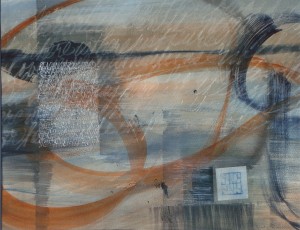I have been remiss in posting the past few weeks. I won’t bore you with all the details except to say that it involved both a marvelous week with our granddaughter Alex and spending some time gathering photographs and typing information for entries to LAR. I’m still knee deep in engraving, but taking time in both the studio and the garden is good for the soul. Here are a few things I’ve been working on.
I’ve been experimenting with water-soluble pencils, including the
Derwent graphite and watercolor. The result is intriguing and has lots of possibilities.
 Using blind writing as a resist, watercolors with only one or two pigments, and letter shapes as background give this a depth that’s hard to achieve with a paste paper background. I work in layers allowing one to dry before adding the next. I love Daniel Smith paints and use them almost exclusively now. I like that you can buy watercolors, acrylics and printmaking inks all in the same color ranges. The piece to the right uses wax pencil, watercolor and gouache on Arches text wove.
Using blind writing as a resist, watercolors with only one or two pigments, and letter shapes as background give this a depth that’s hard to achieve with a paste paper background. I work in layers allowing one to dry before adding the next. I love Daniel Smith paints and use them almost exclusively now. I like that you can buy watercolors, acrylics and printmaking inks all in the same color ranges. The piece to the right uses wax pencil, watercolor and gouache on Arches text wove.
BTW, here’s a little studio tip I gleaned from friends at Cheerio – add a bit of Dr. Martin’s Bleedproof White to your white gouache (I usually use W&N permanent white) and it will pop out better on that background. I also always decant my whites into a second container, even though I try to reserve a few nibs just for white, you never know when your pen might have a bit of color left in it; no point in ruining a whole bottle of Dr. Martin’s with a random bit of gouache or watercolor.
And lastly, if you’re looking for some end of summer reading material, you might check out Free Play, Inspiration in Life and Art by Stephen Nachmanovitch. It won’t make practicing those letter forms any easier, but you’ll find lots of reasons to play while you practice. You can never tell when one of those “happy accidents” might grace your page.













